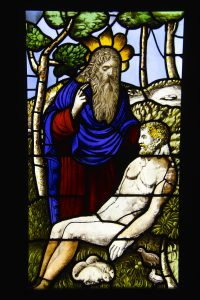Equipping Members of the Next Generation of Christians to Defend Their Faith and to Embrace a Biblical Worldview, Part 13
Redemption is not just about being saved from the consequences of sin, it is also about being saved to something—to resume the task for which we were originally created. And what was that task? In Genesis, God gives what we might call the first job description: “Be fruitful and multiply, and fill the earth and subdue it.”
—Nancy Pearcy—
And whatever you do, do it heartily, as to the Lord and not to men, knowing that from the Lord you will receive the reward of the inheritance; for you serve the Lord Christ.
—Colossians 3:23-24—
Key point: Christians are to glorify God in all they do, not just in their “spiritual” activities and efforts.
You can find links to all the articles in this series here.
In numerous posts in the past,1 we have considered evidence in the natural world that people are special. In some instances we looked at this evidence against the backdrop of Scripture and in others by itself. Regardless of the approach we took, we saw that nature is clear regarding the uniqueness of human beings.
Examining nature’s testimony is a first step in understanding how remarkable people are, but it is not the most important one. The created order tells us that people are special, but it doesn’t tell us why. The Bible does.
The created order tells us that people are special, but it doesn’t tell us why. The Bible does.

“In the beginning,” the Bible says, “God created the heavens and the earth.” Scripture goes on to report about the six days of God’s creative activity.
- In Genesis 1:1-5, the Bible says that God created the heavens and the earth. He also created light and separated it from darkness, resulting in day and night. Then the Bible states, “So the evening and the morning were the first day” (v. 5).
- Similar phrases also mark “the second day” (v. 8), when God made the heavenly firmament, or sky, and separated the water above from the water below;
- “the third day” (v. 13) when God caused dry land to appear and created plant life;
- “the fourth day” (v. 19), when God created the sun, moon, and stars;
- “the fifth day” (v. 23), when God made sea creatures and birds; and
- “the sixth day” (v. 31), when God made land-dwelling animals and people.
Genesis 2:1-2 next tells us God’s creative work was complete, and God rested on the seventh day and established it as holy.
The Biblical Record
No creative activity is described in the manner the Bible portrays God’s creation of the first man and woman. Here is Genesis 1:26-31.

26 Then God said, “Let Us make man in Our image, according to Our likeness; let them have dominion over the fish of the sea, over the birds of the air, and over the cattle, over all the earth and over every creeping thing that creeps on the earth.” 27 So God created man in His own image; in the image of God He created him; male and female He created them. 28 Then God blessed them, and God said to them, “Be fruitful and multiply; fill the earth and subdue it; have dominion over the fish of the sea, over the birds of the air, and over every living thing that moves on the earth.”
29 And God said, “See, I have given you every herb that yields seed which is on the face of all the earth, and every tree whose fruit yields seed; to you it shall be for food. 30 Also, to every beast of the earth, to every bird of the air, and to everything that creeps on the earth, in which there is life, I have given every green herb for food”; and it was so. 31 Then God saw everything that He had made, and indeed it was very good. So the evening and the morning were the sixth day.
Here is Genesis 2:4-9,15-25
4 This is the history of the heavens and the earth when they were created, in the day that the Lord God made the earth and the heavens, 5 before any plant of the field was in the earth and before any herb of the field had grown. For the Lord God had not caused it to rain on the earth, and there was no man to till the ground; 6 but a mist went up from the earth and watered the whole face of the ground.
7 And the Lord God formed man of the dust of the ground, and breathed into his nostrils the breath of life; and man became a living being.
8 The Lord God planted a garden eastward in Eden, and there He put the man whom He had formed. 9 And out of the ground the Lord God made every tree grow that is pleasant to the sight and good for food. The tree of life was also in the midst of the garden, and the tree of the knowledge of good and evil.…
15 Then the Lord God took the man and put him in the garden of Eden to tend and keep it. 16 And the Lord God commanded the man, saying, “Of every tree of the garden you may freely eat; 17 but of the tree of the knowledge of good and evil you shall not eat, for in the day that you eat of it you shall surely die.”

18 And the Lord God said, “It is not good that man should be alone; I will make him a helper comparable to him.” 19 Out of the ground the Lord God formed every beast of the field and every bird of the air, and brought them to Adam to see what he would call them. And whatever Adam called each living creature, that was its name. 20 So Adam gave names to all cattle, to the birds of the air, and to every beast of the field. But for Adam there was not found a helper comparable to him.
21 And the Lord God caused a deep sleep to fall on Adam, and he slept; and He took one of his ribs, and closed up the flesh in its place. 22 Then the rib which the Lord God had taken from man He made into a woman, and He brought her to the man.
23 And Adam said:
“This is now bone of my bones
And flesh of my flesh;
She shall be called Woman,
Because she was taken out of Man.”
24 Therefore a man shall leave his father and mother and be joined to his wife, and they shall become one flesh.
25 And they were both naked, the man and his wife, and were not ashamed.
God’s Masterpieces
On that sixth day when God created the first man and the first woman, many significant things happened. This list refers to those things the Lord did in relation to creating Adam and Eve, even though in some instances God did similar things with regard to other members of the created order. The point is that we do well to note those things He did in bringing the first man and woman into existence.
- God didn’t bring the man into being in exactly the same way He moved to create the other elements and creatures He had made. He first deliberated within the Godhead about what He was going to do. We assume these all-important words were spoken within the Godhead, among the members of the Trinity. Furthermore, it is reasonable to believe that the Father is speaking to the Son and the Holy Spirit: “Let Us make man in Our image, according to Our likeness; let them have dominion over the fish of the sea, over the birds of the air, and over the cattle, over all the earth and over every creeping thing that creeps on the earth” (1:26).
- God made man “in His image” and “according to His likeness” (1:26). The Latin term for “image of God” is imago Dei.
- God gave “them” — male and female human beings — “dominion” or authority “over the fish of the sea, over the birds of the air, and over the cattle, over all the earth and over every creeping thing that creeps on the earth.” (1:26). This indicates both the man and woman both had responsibilities to fulfill and work to accomplish.
- God created both male and female human beings, and He did so separately (see 1:27; 2:7,21-22).
- “God blessed them” (1:28).
- God instructed them to “[b]e fruitful and multiply; fill the earth and subdue it; have dominion over the fish of the sea, over the birds of the air, and over every living thing that moves on the earth (1:28).” Charles Colson and Nancey Pearcey call this the “cultural commission” and boldly declare it “is inseparable from the great commission.”2 We’ll return to this idea in a few moments.
- God offered the two sustenance and directed them regarding the food that would be theirs (see 1:29).
- After creating the man and the woman, God saw all that He had made, and declared it to be “very good” (1:31).Background: During the first day of the six days of creation, God created light. Genesis 1:4 reports God’s assessment of His work: “And God saw the light, that it was good.” A similar phrase appears six more times in Genesis 1, occurring
- on day 3 and referring to the dry land and the seas (see 1:10),
- on day 3 and referring to plant life (see 1:12),
- on day 4 and referring to the heavenly bodies of light and their rule over the day and night (see 1:18),
- on day 5 and referring to sea creatures and birds (see 1:21),
- on day 6 and referring to land animals (see 1:25), and finally
- on day 6 at the end of God’s creative work, assessing all that God had created (see 1:31). In this last statement of evaluation, the Hebrew word for very is added: “God saw all that He had made, and it was very good.”
- Genesis 2:5 tells us that “the Lord God had not caused it to rain on the earth, and there was no man to till the ground.” Here we see an indication of the productive work God would assign the man. Note carefully that God assigned work before the fall. In verse 15 we see God’s placing the man in the garden “to tend and keep it.”
- God didn’t just “speak” the man into existence as He had other items in His creation but He “formed man of the dust of the ground, and breathed into his nostrils the breath of life; and man became a living being” (2:7, emphasis added).
- In Genesis 2:16-17 we see God’s placing the man in the position of eventually having to make a moral choice, and a choice that would reveal his ultimate allegiance: 16“And the Lord God commanded the man, saying, ‘Of every tree of the garden you may freely eat; 17 but of the tree of the knowledge of good and evil you shall not eat, for in the day that you eat of it you shall surely die.’”
- God stated explicitly that it was “not good that man should be alone” and that He would “make him a helper comparable to him” (2:18).
- God not only gave Adam constructive work to do when He had him name the animals; He also gave him an experiential lesson that taught him no existing creature could serve as “a helper comparable to him” (2:20). Man (including both men and women, of course) is capable of learning, reasoning, and engaging in intellectual creativity.
- The creation of the woman was special: God put Adam to sleep, took one of his ribs, and “made [it] into a woman, and He brought her to the man” (2:21-22).
- Interestingly, a different word is used to refer to God’s creating the man ( “the Lord God formed man of the dust of the ground” [2:7]) and His creating the woman ( “the rib which the Lord God had taken from man He made into a woman” [2:22]). We might say that God formed the man, or created him, as a potter would fashion a clay pot on a wheel; but He “built” or constructed the woman. Apparently creating the woman involved divine planning and deliberation not employed in His creating the man.
- Adam received the woman as a partner comparable to him, as one “taken out of” him (v. 23). Eve was like Adam in that she was human, but she was different from him in that she was a woman and he was a man.
- Marriage, which is unique to the human family, is designed by God and occurs between one man and one woman (see v. 24).
- These are the elements of marriage according to Genesis 2:24: 1) a man’s leaving his father and mother, 2) a man’s being joined to his wife, and 3) the union of the man and his wife into a “one flesh” relationship. This includes but is not limited to the reproduction of children and the formation of a multi-generational family.
- While parents and their children are families, a husband and his wife by themselves are a family as well. Like marriage, families are unique to human beings.
- The nakedness of the man and the woman in Genesis 2:25 related to their union but also to their own relationship with God, which was still intact and unhindered before the fall. In other words, the man and the woman didn’t just have a special, intimate relationship between themselves, but each had an intimate relationship with God.

Male and Female
Writing for Focus on the Family, Jeff Johnston makes some very important observations. We summarize them as follows.
Genesis tells us God spoke the world into being. He went on to create other things in addition, including light, heavenly bodies, plants, sea life, birds, and land creatures. God also separated contrasting elements. He divided land from water, the heavens from the earth, day from night, and light from darkness.
Significantly, the narrative in Genesis changes when it reports God’s creation of human beings. The Lord first fashioned the man from the ground, and then a bit later, He made the woman from the man’s rib, or side. We note that the man’s rib was close to his heart. God created the man and the woman alike in that both are human and bear His image; yet He made each one different from the other. Some of the traits that are unique to human beings Adam and Eve shared; but other such traits were unique to him, and still others unique to her. Of course, both individuals are equal in worth and infinitely valuable.
We can trace our English word for sex to a Latin term meaning to separate, divide, or cut. This highlights the reality that the human race is composed of two primary groups. Males and females are distinct from each other, even though they’re all human beings. The writings of both Moses and Paul emphasize the creation of humanity as male and female persons, and the words of Jesus carry this same emphasis. This is a bedrock truth with many profound and far-reaching implications.
Adam celebrated when God presented Eve to him. He knew that this person was like him, yet different from him. She would be a “helper comparable to him” (Gen. 2:18). Yet Adam would be Eve’s partner as well. God created each for the other and brought the two together in marriage. There, together in that divinely ordained union, the man and the woman would be able to display God’s image to the world in ways neither one could showcase it individually.
In marriage—the divinely created lifelong union of one man and one woman—the man and the woman are able to display God’s image to the world in ways neither one can showcase it individually.
The Cultural Commission
In a recent post, we gave consideration to what it means that God creates men, women, boys, and girls in His image. One item that we did not discuss specifically was what some Bible scholars call the “cultural mandate” or the “cultural commission.” This divine directive is yet another element setting human beings apart and helping us to better understand the meaning of having been made in God’s image.
As we mentioned previously, we find the cultural commission in Genesis 1:28: “Be fruitful and multiply; fill the earth and subdue it; have dominion over the fish of the sea, over the birds of the air, and over every living thing that moves on the earth.”

Charles Colson and Nancy Pearcy contend that when God gives this directive to Adam and Eve at this point on the sixth day of creation, He essentially passes the baton of work in the world to the human agents He has created. It is not His intention to abandon His creation or the people who are in it, for He still will be involved with them in a variety of ways. A great deal of social and cultural work now must be done to maintain the created order, but now, people will accomplish this work. The specific tasks involved relate directly to the God-given responsibilities of having dominion over creation and filling and subduing the earth.

While sin has entered the world since God gave the command we find in Genesis 1:28, the tasks of human beings remain essentially the same. Couples still bear children and rear them in the context of family. People still plant and tend crops and raise animals for food and to perform needed services. They form and maintain neighborhoods, communities, cities, and nations. They also engage in creative endeavors by writing and performing music, producing works of literature, making films, and creating works of visual art.3
With God’s help, Christians can show the world what Christ would do were He physically present and involved in variety of endeavors.
In other words, the fall did not wipe out God’s cultural directive. Furthermore, Christians, more than any other group of people, can demonstrate that sin doesn’t have to overshadow it.4 In the context of life as it continues to unfold, believers have countless special opportunities to show the world what Christ would do were He physically present and involved in a wide variety of endeavors.
Redeeming Culture, Not Just People
Yes, sin rears its ugly head regularly, but Christ’s influence through His followers counters evil forces and contrasts sharply to them. In this we see the connection between the cultural commission and the great commission. Such displays are instructive to a lost world regarding the triumphant power of Christ. Colson and Pearcy make this very point.
Sin rears its ugly head regularly, but Christ’s influence through His followers counters evil forces and contrasts sharply to them. In this we see the connection between the cultural commission and the great commission. Such displays are instructive to a lost world regarding the triumphant power of Christ.
The truth is that
when we are redeemed, we are not only freed from the sinful motivations that drive us but also restored to fulfill our original purpose, empowered to do what we were created to do: to build societies and creature culture—and in doing so, to restore the created order.

It is our contention…that the Lord’s cultural commission is inseparable from the great commission. That may be a jarring statement for many conservative Christians, who, through much of the twentieth century, have shunned the notion of reforming culture, associating that concept with the liberal social gospel. The only task of the church, many fundamentalists and evangelicals have believed, is to save as many lost souls as possible from a world literally going to hell. But this implicit denial of a Christian worldview is unbiblical and is the reason we have lost so much of our influence in the world. Salvation does not consist simply of freedom from sin; salvation also means being restored to the tasks we were given in the beginning—the job of creating culture.5
The Lordship of Christ
In their book What if Jesus Had Never Been Born? D. James Kennedy and Jerry Newcombe concur, and they explicitly connect the cultural mandate in Genesis 1:28 to Christ’s lordship. If Jesus is Lord of all and has created the world for the good of man and the glory of God, the Christian has a duty to take the resources afforded him through God’s creative work and “shape them and use them for his own well-being, the well-being of his neighbor, and the glory of God.”6
Here we add an important caveat. Be aware that numerous movements in Christian circles may sound like efforts to fulfill the cultural commission, but aren’t necessarily. In particular, Christians should beware of the social justice movement, in which many Christians are calling on government to exercise “generosity” and “compassion” through taxation and redistribution of wealth.
That said, we see evidence all around us that believers must rediscover the cultural mandate and apply it afresh it in our day, both individually and corporately.
God isn’t merely interested in having you join Him in heaven for eternity.
He wants to use you as Christ’s representative here and now, in every sphere of influence that is yours.
Copyright © 2018 by B. Nathaniel Sullivan. All rights reserved.
Unless otherwise indicated, Scripture passages have been taken from the New King James Version®. Copyright © 1982 by Thomas Nelson, Inc. Used by permission. All rights reserved.
Notes:
1 Here are some of the articles that highlight nature’s testimony regarding the human family.
- God Speaks Clearly Through Nature
- Upholding Clarity in an Age of Confusion: The Nashville Statement, Part 6: An Open Door
- Contending for the Recognition of Absolutes, Part 3: Relativism’s Bitter Fruit
- America, Where Are You? Part 4, The Attack on Marriage
- Two Distinctive Elements of the Christian Worldview, Continued
God Made Human Beings in His Image.
2Charles Colson and Nancy Pearcey, How Now Shall We Live? (Wheaton, IL: Tyndale, 1999), 295.
3Ibid.
4Ibid.
5Ibid., 295-296.
6D. James Kennedy and Jerry Newcombe, What if Jesus Had Never Been Born? (Nahsville: Nelson, 1994), 96.
top image: Photo by Dominik Scythe on Unsplash
Copyright © 2018 by B. Nathaniel Sullivan. All rights reserved.

Be First to Comment